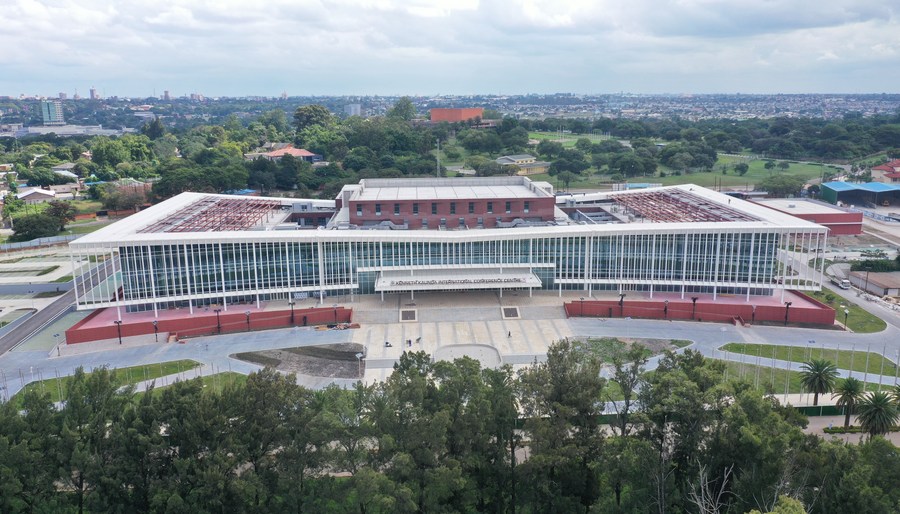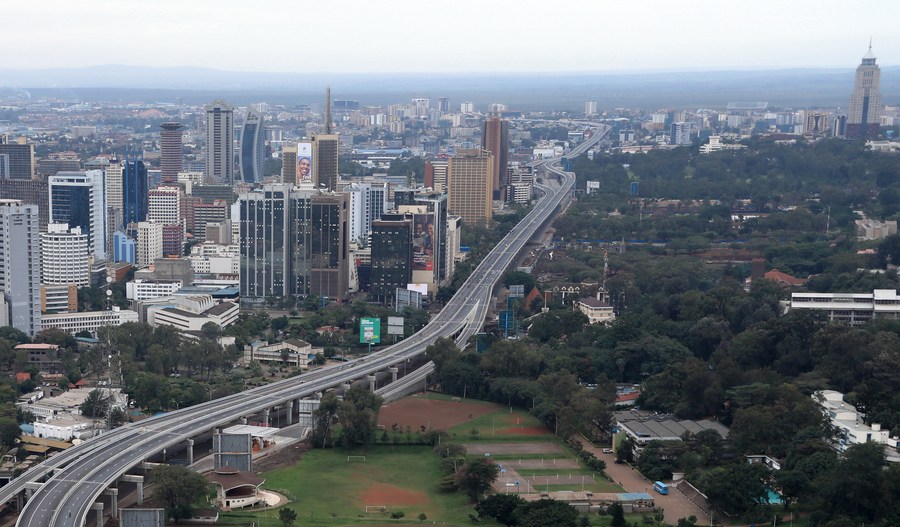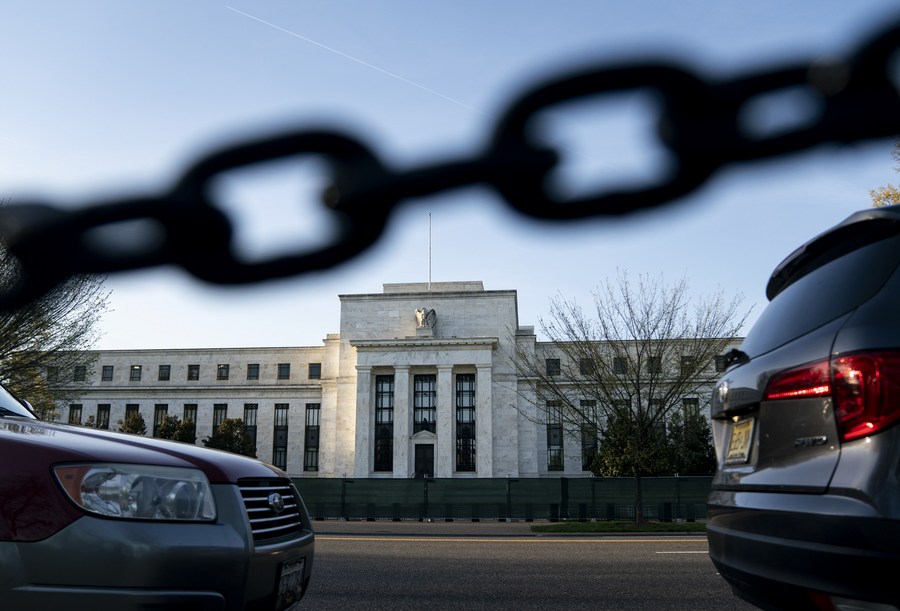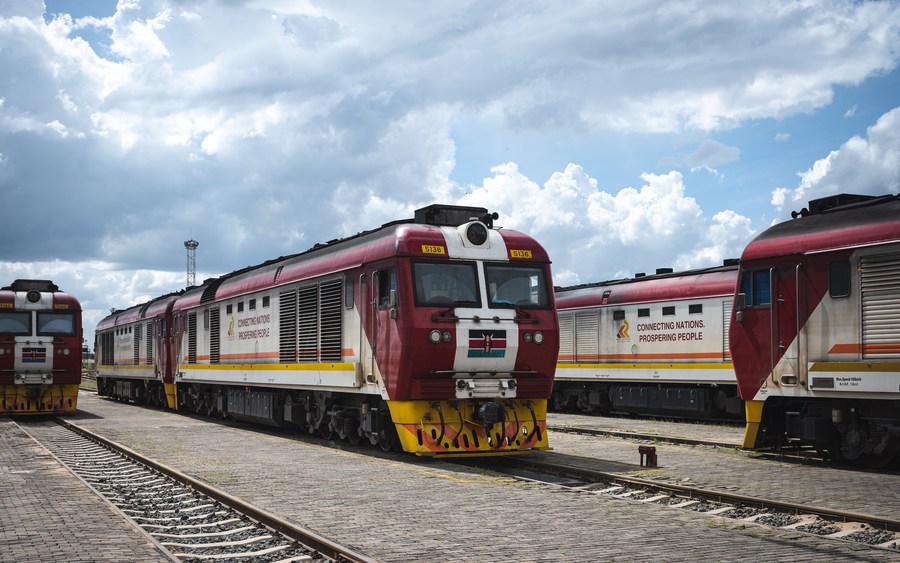Published : June 30,2023
by Tian Dongdong, Liu Tian and Han Bing

Countries defaulting, inflation soaring, people losing jobs and their families facing starvation … This is the bleak picture painted by Western media of the world’s poorest countries falling into a “debt trap.”
China, again, became an easy target to blame. A recent Associated Press (AP) story, titled “China’s loans pushing world’s poorest countries to the brink of collapse,” accused China of setting up the so-called “debt trap” and labeled it as the “world’s biggest and most unforgiving government lender.”
But does this allegation hold water?
On-site investigations conducted by Xinhua on several countries, including Pakistan, Kenya, Zambia and Sri Lanka, present a contrasting perspective to the AP report, shedding new light on their debt impasse.

Aerial photo taken on April 9, 2022 shows the Kenneth Kaunda International Conference Center, financed by China, in Lusaka, Zambia. (Xinhua)
THE BIGGEST LENDER ISN’T CHINA
According to the National Treasury of Kenya, Kenya’s external debt stock stood at 36.66 billion U.S. dollars at the end of March 2023. The debt is owed to multilateral lenders (46.3 percent) and bilateral sources (24.7 percent), among others. As of March 2023, Kenya owed Chinese entities, including Chinese banks and companies, 6.31 billion dollars, but the largest chunk of Kenya’s debt — 17 billion dollars — is owed to the International Monetary Fund (IMF) and the World Bank (WB).
Citing World Bank IDS data, a Briefing Paper titled “Integrating China into Multilateral Debt Relief: Progress and Problems in the G20 DSSI,” released by the Johns Hopkins University in April, showed that “China (Chinese entities) only holds 21 percent of Kenya’s public external debt, with private creditors holding another 24 percent and multilateral institutions 45 percent.”
Data exclusively given to Xinhua by the Economic Affairs Division (EAD) of Pakistan showed that as of April 2023, Pakistan’s total external debt was 125.702 billion dollars, while the loan from Chinese entities was 20.375 billion dollars, and some 4 billion dollars more from the Chinese side as safe deposits, making Chinese entities’ debt in Pakistan only 16.2 percent of its total (without adding the safe deposits).
“This (AP’s story) is not the first story. It is a series of stories (to defame China),” Shakeel Ahmad Ramay, CEO of the Asian Institute of Eco-civilization Research and Development in Pakistan, told Xinhua.
Meanwhile, in Sri Lanka, data released by the country’s Central Bank and Ministry of Finance, Economic Stabilization & National Policy showed that as of March 2023, Sri Lanka’s existing external public debt is 27.6 billion dollars, with private creditors taking the lion’s share at 14.8 billion dollars (53.6 percent), multilateral creditors 5.7 billion dollars (20.6 percent). Chinese entities’ share is 3 billion dollars (10.8 percent).
In the case of Zambia, “the Chinese (entities’) debt is only one-third of what Zambia owes externally. So if we were to worry as a country, we must worry about the two-thirds. This is two-thirds that is not owed to China (Chinese entities); it’s owed to Western donors, multilateral institutions and bilateral ones,” said Chibeza Mfuni, deputy secretary general of the Zambia-China Friendship Association.
“How much foreign debt does Zambia owe? It’s an excess of 18.6 billion dollars by the end of 2022, and how much of that 18.6 billion dollars is owed to Chinese entities? It’s around 6 billion dollars,” said Mfuni.
According to WB statistics, nearly three-quarters of Africa’s total external debt is held by multilateral financial institutions and commercial creditors, making them the largest creditors in Africa, said Wang Zhan, member of the International Finance and Economics Research Expert Studio of China’s Ministry of Finance.
In a nutshell, Africa’s main creditors are from the West, not from China.

Photo taken on May 8, 2022 shows the Nairobi Expressway constructed by the China Road and Bridge Corporation (CRBC) in Nairobi, Kenya. (Xinhua/Dong Jianghui)
CHINA FULFILLED ITS ROLE FAIRLY WELL IN DEBT RELIEF
In the article, AP claimed, “Behind the scenes is China’s reluctance to forgive debt,” portraying the country as an unforgiving lender.
Responding to the AP story, Song Wei, professor at the School of International Relations and Diplomacy, Beijing Foreign Studies University, said that China’s contribution to debt relief exemplifies the international obligations expected of a responsible major country.
Amid the growing concerns of a debt default, China has always adhered to the principle of equality in bilateral relations and proactively participates in just and fair negotiations with different nations, Song said. “Furthermore, when the G20 announced the COVID-19 Debt Service Suspension Initiative (DSSI), China promptly expressed its support.”
In the Briefing Paper, Deborah Brautigam, director of the China Africa Research Initiative at Johns Hopkins University’s School of Advanced International Studies, said, “China fulfilled its role fairly well as a responsible G20 stakeholder implementing the DSSI in the challenging circumstances of the COVID-19 pandemic. In the 46 countries that participated in the DSSI, Chinese creditors accounted for 30 percent of all claims, and contributed 63 percent of debt service suspensions.”
Song said she believes China is a genuine partner for developing countries needing capital to support nation-building projects.
“Moreover, debt suspension and relief should be a collective effort: multilateral, bilateral, commercial. China’s proposal of shared responsibility in debt relief is fair and reasonable since all parties involved are creditors. It is unjust for only one side to bear the burden of debt reduction while others are exempted from their responsibilities,” Song said.
Referring to data from the WB, professor Ding Yibing, dean of School of Economics, Jilin University, highlighted that since 2016, China, as a bilateral creditor, has been responsible for roughly 16 percent of global debt relief, surpassing the United States and the WB, adding that China’s debt reduction has already doubled the average reduction scale of the G7 countries.
“Among G20 members, China has provided the largest debt relief overall,” said Ding. “However, China’s proportion of debt to Africa as a whole is not high. Multilateral financial institutions and commercial creditors hold the highest share of debt. Even without China’s debt, these countries still face high debt pressure.”

This photo taken on April 20, 2022 shows the U.S. Federal Reserve in Washington, D.C., the United States. (Xinhua/Liu Jie)
WHO’S TO BLAME?
In recent years, various factors such as the U.S. Federal Reserve’s interest rate hikes, global commodity price cycles, the economic structures of certain developing nations, the COVID-19 pandemic and the Ukraine crisis have led to a liquidity shortage. This has severely constrained the repayment capacity of some developing countries, leading to sovereign debt crises.
Therefore, placing blame on China for the debt crisis is unjust and misleading. A detailed case study of Pakistan can provide a clearer understanding of the situation.
The AP story said a dozen countries “most indebted to China,” including Pakistan, “found paying back that debt is consuming an ever-greater amount of the tax revenue needed to keep schools open, provide electricity and pay for food and fuel.”
But for Ramay, “Pakistan under the burden of Chinese debt is not a true statement.”
Considering all the funds that China has provided to Pakistan, including the safe deposits, it amounts to approximately 20 percent. “And as I mentioned, most money came as a swap. They are reserves in Pakistani banks to avoid default. The rest are concessional loans trying to help us create economic opportunities for more financial resources and revenue, which will help to avert our debt crisis,” said Ramay.
“Our real problem is the foreign debt from the Western financial institutions. Pakistan cannot pay them back because they are high-interest loans. Some of them, like private debt, are even higher,” said Ramay. “Pakistan also sold bonds in the Western market at a higher rate. Those all are causing real problems for Pakistan.”

People board the Orange Line metro train in Lahore, Pakistan, Dec. 29, 2021. Officially open to traffic on Oct. 25, 2020, the eco-friendly Orange Line metro train is an early project under the China-Pakistan Economic Corridor (CPEC), a flagship project of the China-proposed Belt and Road Initiative. (Photo by Jamil Ahmed/Xinhua)
Take the textile industry. In its story, AP said, “In Pakistan, millions of textile workers have been laid off because the country has too much foreign debt and can’t afford to keep the electricity on and machines running.”
For Shahid Sattar, secretary general of the All Pakistan Textile Mills Association, the sector was hit by a “perfect storm” of a liquidity shortage caused by the significant change in rupee-dollar parity, delays in sales tax refunds and the cotton crop failure in Pakistan.
“But to blame it on China is completely absurd. China has been working with Pakistan to resolve our economic issues sustainably,” Shahid said.
For Mfuni, former deputy head of the Zambian mission in Beijing, Chinese debt has the lowest interest rates, lower than Western and multilateral debt, the IMF, the WB and especially private lenders.
“Our biggest problem is not the Chinese debt but the vulture funds. They are not interested in debt forgiveness,” but expect China to be, said Mfuni.
“I think we must be factual. The interest rates from Western lenders are higher … Countries have been stuck paying the interest, and the principal remains unpaid for a long time. What does that represent? It represents the rate of exploitation,” said Mfuni.
According to Lewis Ndichu, a researcher at the Africa Policy Institute in Nairobi, Kenya’s debt challenges should not be attributed to China but to the spillover effects of the Ukraine crisis and global economic uncertainties.
“Kenya’s debt dilemma is not a Chinese problem. It’s not a China problem thing,” said Ndichu.
Ndichu refuted the AP claim: “In Kenya, the last key miles of a railway were never built due to poor planning and a lack of funds.” He said funding isn’t the issue.
“China thought it was important to give African countries time to stabilize because we started paying back debt for the SGR (standard gauge railway) in 2020. The government is now able to reap the impacts of the SGR and is slowly on the right track regarding its debt sustainability for the SGR. When the time comes, especially now we have the new government, we can start on the second leg of the SGR,” said Ndichu.

This photo taken on May 23, 2023 shows trains of the Mombasa-Nairobi Railway in Nairobi, Kenya. The Mombasa-Nairobi Standard Gauge Railway in Kenya has become a flagship project of China-Africa cooperation, a “business card” of Chinese enterprises and a demonstration project of the Belt and Road Initiative. (Xinhua/Wang Guansen)
Economically vulnerable nations often fall victim to debt crises due to financial downturns transmitted by the West. From 2022, the U.S. monetary policy went from extreme looseness to rapid interest rate hikes, which catalyzed the outbreak of debt problems in some poor countries.
With the dollar’s dominance, the United States implemented rounds of quantitative easing and lowered interest rates to near zero, causing a significant inflow of low-interest dollars into Africa and emerging markets. However, it later increased interest rates aggressively, leading to a stronger dollar and capital outflows. Consequently, this resulted in a liquidity shortage, disrupted funding chains, currency depreciation, and a surge in sovereign debt, said Ye Jianru, associate professor at Guangdong University of Foreign Studies.
For Ye, also researcher at the Institute of African Studies of Guangdong University of Foreign Studies, an unfair global financial system led by the United States is the root cause of Africa’s debt problem.
The global financial governance system, centered on the U.S. dollar and institutions like the IMF and WB, puts African countries at a disadvantage. Africa has limited representation in the IMF and faces high financing costs due to bias from major rating agencies favoring the United States and Western countries.
As a result, African nations experience rapid credit rating downgrades and increased debt servicing expenses during liquidity challenges. Despite being the largest shareholder in the WB and IMF, the United States needs to take more action to address Africa’s debt issues or offer viable solutions, said Ye.
Despite China not being the largest lender and offering unconditional debt relief, Western critics persist in spreading the “China debt trap” lie.
Song, from Beijing Foreign Studies University, highlighted the importance of how the West perceives China’s rise as a new lending nation, whether with a competitive or cooperative attitude, which directly impacts mutual trust.
“Too often, Chinese loans are seen as neocolonialist. In fact, China does not lend simply for profits. It provides loans to foster progress and cooperation,” said Song.
During his trip to Africa in January, Chinese Foreign Minister Qin Gang said Africa’s debt problem is essentially an issue of development and China’s financing cooperation with Africa is mainly in areas such as infrastructure construction and production capacity, with a view to enhancing Africa’s capacity for independent and sustainable development.
The so-called “debt trap” is a narrative trap imposed on China and Africa. Only the African people are in the best position to say whether cooperative China-Africa projects contribute to the development of the continent and the improvement of people’s livelihood, he added. Enditem
Source: Xinhua
 Africa -China Review Africa -China Cooperation and Transformation
Africa -China Review Africa -China Cooperation and Transformation
